Ankle Exercises
Medically reviewed by Drugs.com. Last updated on Aug 4, 2025.
AMBULATORY CARE:
What you need to know about ankle exercises:
Ankle exercises help strengthen your ankle and improve its function after injury. These are beginning exercises. Ask your healthcare provider if you need to see a physical therapist for more advanced exercises.
General guidelines for ankle exercises:
- Do these exercises 3 to 5 days a week, or as directed by your healthcare provider. Ask if you should do the exercises on each ankle.
- Do the exercises in the order that your healthcare provider recommends. This will help prevent swelling, chronic pain, and reinjury. Start with range of motion exercises. Then move to strengthening exercises, and finally to balancing exercises.
- Warm up before you do ankle exercises. Walk or ride a stationary bike for 5 to 10 minutes to prepare your ankle for movement.
- Stop if you feel pain. It is normal to feel some discomfort at first but you should not feel pain. Tell your doctor or physical therapist if you have pain while you exercise. Regular exercise will help decrease your discomfort over time.
How to perform range of motion exercises safely:
Begin with range of motion exercises to improve flexibility. Ask your healthcare provider when you can progress to strengthening exercises.
- Ankle alphabet: Sit on a chair so that your feet do not touch the floor. Use your big toe to write each letter of the alphabet. Use only your foot and ankle, and keep your movements small. Do 2 sets.
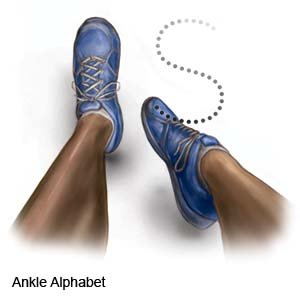
- Calf stretches:
- Sitting calf stretches with a towel: Sit on the floor with both legs out straight in front of you. Loop a towel around the ball of your injured foot. Grasp the ends of the towel and pull it toward you. Keep your leg and back straight. Do not lean forward as you pull the towel. Hold for 30 seconds. Then relax for 30 seconds. Do 2 sets of 10.
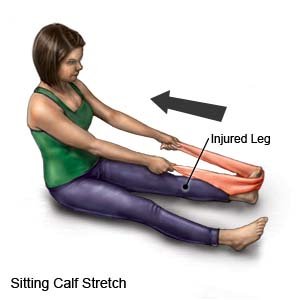
- Standing calf stretches: Stand facing a wall with the foot that is not injured forward and your knee slightly bent. Keep the leg with the injured foot straight and behind you with your toes pointed in slightly. With both heels flat on the floor, press your hips forward. Do not arch your back. Hold for 30 seconds, and then relax for 30 seconds. Do 2 sets of 10. Repeat with your leg bent. Do 2 sets of 10.
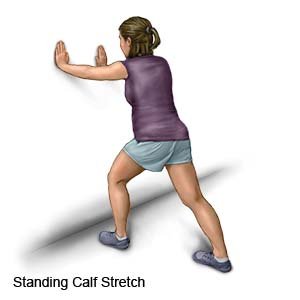
- Sitting calf stretches with a towel: Sit on the floor with both legs out straight in front of you. Loop a towel around the ball of your injured foot. Grasp the ends of the towel and pull it toward you. Keep your leg and back straight. Do not lean forward as you pull the towel. Hold for 30 seconds. Then relax for 30 seconds. Do 2 sets of 10.
How to perform strengthening exercises safely:
After you can perform range of motion exercises without pain, you may begin strengthening exercises. Ask your healthcare provider when you can progress to balancing exercises.
- Ankle movement in 4 directions: Sit on the floor with your legs straight in front of you. Keep your heels on the floor for support.
- Dorsiflexion: Begin with your toes pointing straight up. Pull your toes toward your body. Slowly return to the starting position. Do 3 sets of 5.
- Plantar flexion: Begin with your toes pointing straight up. Push your toes away from your body. Slowly return to the starting position. Do 3 sets of 5.
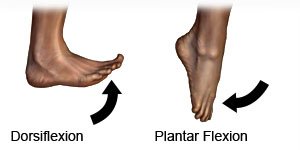
- Inversion: Begin with your toes pointing straight up. Push your toes inward, toward each other. Slowly return to the starting position. Do 3 sets of 5.
- Eversion: Begin with your toes pointing straight up. Push your toes outward, away from each other. Slowly return to the starting position. Do 3 sets of 5.
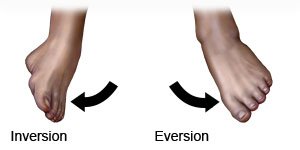
- Toe curls with a towel: Sit on a chair so that both of your feet are flat on the floor. Place a small towel on the floor in front of your injured foot. Grab the center of the towel with your toes and curl the towel toward you. Relax and repeat. Do 1 set of 5.
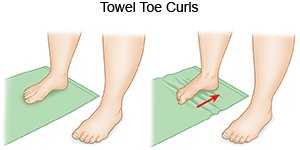
- Marble pick-ups: Sit on a chair so that both of your feet are flat on the floor. Place 20 marbles on the floor in front of your injured foot. Use your toes to pick up one marble at a time and place it into a bowl. Repeat until you have picked up all the marbles. Do 1 set.
- Heel raises:
- Single leg heel raises: Stand with your weight evenly on both feet. Hold on to a chair or a wall for balance. Lift the foot that is not injured off the floor so all your weight is placed on your injured foot. Raise the heel of your injured foot as high as you can. Slowly lower your heel to the floor. Do 1 set of 10.
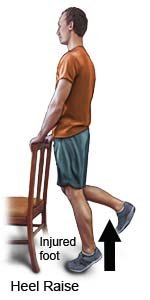
- Double leg heel raises: Stand with your weight evenly on both feet. Hold on to a chair or a wall for balance. Raise both of your heels as high as you can. Slowly lower your heels to the floor. Do 1 set of 10.
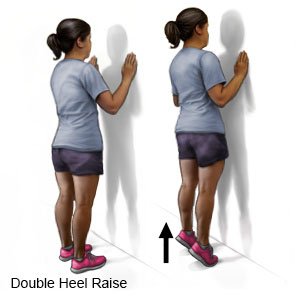
- Single leg heel raises: Stand with your weight evenly on both feet. Hold on to a chair or a wall for balance. Lift the foot that is not injured off the floor so all your weight is placed on your injured foot. Raise the heel of your injured foot as high as you can. Slowly lower your heel to the floor. Do 1 set of 10.
- Heel and toe walks:
- Heel walks: Begin in a standing position. Lift your toes off the floor and walk on your heels. Keep your toes lifted as high as possible. Do 2 sets of 10.
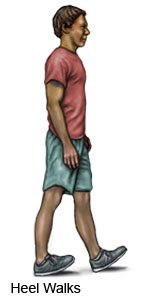
- Toe walks: Begin in a standing position. Lift your heels off the floor and walk on the balls and toes of your feet. Keep your heels lifted as high as possible. Do 2 sets of 10.
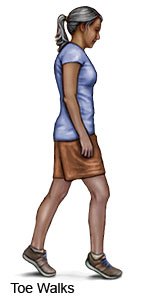
- Heel walks: Begin in a standing position. Lift your toes off the floor and walk on your heels. Keep your toes lifted as high as possible. Do 2 sets of 10.
How to perform a balance exercise safely:
After you can perform strengthening exercises without pain, you may do this beginning balancing exercise. Ask your healthcare provider for more advanced balance exercises.
- Single leg stance: Stand with your weight evenly on both feet, or hold on to a chair or a wall. Do not lean to the side. Lift the foot that is not injured off the floor so all your weight is placed on your injured foot. Balance on your injured foot. Ask your healthcare provider how long to hold this position.
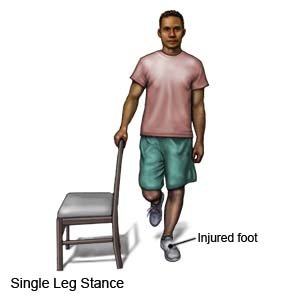
Call your doctor or physical therapist if:
- You have new pain, or your pain becomes worse.
- You have questions or concerns about your condition, care, or exercise program.
© Copyright Merative 2025 Information is for End User's use only and may not be sold, redistributed or otherwise used for commercial purposes.
The above information is an educational aid only. It is not intended as medical advice for individual conditions or treatments. Talk to your doctor, nurse or pharmacist before following any medical regimen to see if it is safe and effective for you.
Further information
Always consult your healthcare provider to ensure the information displayed on this page applies to your personal circumstances.
